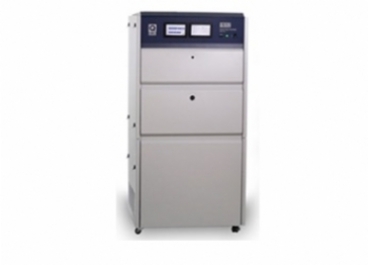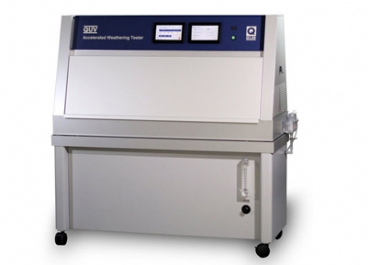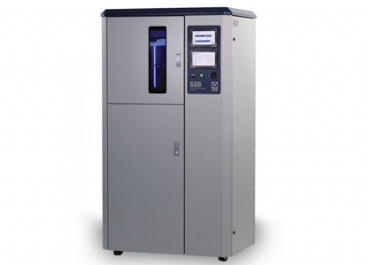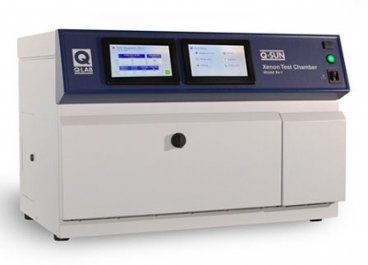咨询热线
18566398802ASTM D3424-11测试标准
-> ASTM D3424-11标准介绍
-> 符合ASTM D3424-11的仪器
ASTM D3424-11标准介绍
ASTM D3424是印刷品相对日晒色牢度和耐候性评估的标准测试方法:
ASTM D3424描述了印刷品在下列情况下相对日晒色牢度和耐候性的评估程序,涉及自然光曝露测试程序或实验室加速曝露测试程序。最近的标准版本为2011年修订的。ASTM D3424-11
Q-sun氙灯试验箱ASTM D3424测试方法

ASTM D3424英文介绍(节选)
Significance and Use
Lightfastness or weatherability for specified periods of time is pertinent for certain types of printed matter such as magazine and book covers, posters and billboards, greeting cards and packages. Since the ability of printed matter to withstand color changes is a function of the spectral-power distribution of the light source to which it is exposed, it is important that lightfastness be assessed under conditions appropriate to the end-use application.
The accelerated procedures covered in these exposure methods provide means for the rapid evaluation of lightfastness or weatherability under laboratory conditions. Test results are useful for specification acceptance between producer and user and for quality control.
The xenon-arc lamp with an appropriate filter system exhibits a spectral-power distribution that corresponds more closely to that of daylight than the carbon-arc. In turn, accelerated tests using xenon-arc apparatus may be expected to correlate better with exposure to natural daylight than do those using carbon-arc apparatus.
To accommodate variations in light intensity among days, seasons, locations, or instruments, duration of exposure is preferably expressed as the radiant exposure in specific bandpasses rather than time. In either case, the inclusion of an appropriate control serves to minimize effects of variations in test conditions.
Color changes are not a linear function of duration of exposure. The preferred method of determining lightfastness or weatherability is to expose the prints for a number of intervals and to assess the time or radiant exposure required to obtain a specified color difference.
For a given printing ink, lightfastness and weatherability or both depend on the type of substrate, the film thickness of the print, and the area printed (solid versus screen). Therefore, it is important that the nature of the test and control specimens correspond to that expected under actual use conditions.
Note 2—Specifications D4302, D5067, and D5098 provide useful guides to the lightfastness of pigments in several types of artists' paints after 1260 MJ/m2 total window glass filtered solar radiant exposure (equivalent to about 2 or 3 months' exposure to window glass filtered solar radiation in accordance with Practice G24 at a tilt angle of 45 degrees). However, because of major differences between printing inks and artists' colors, especially in applied film thickness, it cannot be assumed that the lightfastness categories of printed ink films containing these pigments will be comparable to those indicated in the three specifications.
1. Scope
1.1 This standard describes procedures for the determination of the relative lightfastness and weatherability of printed matter under the following conditions, which involve exposure to natural daylight or accelerated procedures in the laboratory:
1.1.1 Method 1—Daylight behind window glass,
1.1.2 Method 2—Outdoor weathering,
1.1.3 Method 3—Xenon-arc apparatus with window glass filters to simulate daylight behind window glass,
1.1.4 Method 4—Xenon-arc apparatus with water spray and daylight filters to simulate outdoor weathering,
1.1.5 Method 7—Fluorescent lamp apparatus to simulate indoor fluorescent lighting in combination with window-filtered daylight.
1.1.6 Method 8—Fluorescent lamp apparatus operating with fluorescent cool white lamps to simulate indoor fluorescent lighting.
Note 1—Previous versions of this standard included Methods 5 and 6 that are based on enclosed carbon-arc exposures. These methods are described in Appendix X1. The spectral irradiance of the enclosed carbon-arc is a very poor simulation of solar radiation, window glass filtered solar radiation, or the emission of lamps used for interior lighting. In addition, enclosed carbon-arc devices are no longer readily available or commonly used.
1.2 These methods require that a suitable print or other control (reference standard) be run along with the test sample. Color changes due to conditions of exposure may be evaluated by visual examination or instrumental measurement.
1.3 These methods are applicable to prints on any flat substrate including paper, paperboard, metallic foil, metal plate, and plastic film, and are produced by any printing process including letterpress, offset lithography, flexography, gravure, and silk screen.
1.4 The values stated in SI units are to be regarded as standard. No other units of measurement are included in this standard.
1.5 This standard does not purport to address all of the safety concerns, if any, associated with its use. It is the responsibility of the user of this standard to establish appropriate safety and health practices and determine the applicability of regulatory limitations prior to use. For specific hazard statements, see Section 8.
2. Referenced Documents (purchase separately)
ASTM Standards
D1729 Practice for Visual Appraisal of Colors and Color Differences of Diffusely-Illuminated Opaque Materials
D2244 Practice for Calculation of Color Tolerances and Color Differences from Instrumentally Measured Color Coordinates
D2616 Test Method for Evaluation of Visual Color Difference With a Gray Scale
D4302 Specification for Artists Oil, Resin-Oil, and Alkyd Paints
D4674 Practice for Accelerated Testing for Color Stability of Plastics Exposed to Indoor Office Environments
D5067 Specification for Artists Watercolor Paints
D5098 Specification for Artists Acrylic Dispersion Paints
E284 Terminology of Appearance
E991 Practice for Color Measurement of Fluorescent Specimens Using the One-Monochromator Method
E1331 Test Method for Reflectance Factor and Color by Spectrophotometry Using Hemispherical Geometry
E1347 Test Method for Color and Color-Difference Measurement by Tristimulus Colorimetry
E1349 Test Method for Reflectance Factor and Color by Spectrophotometry Using Bidirectional (45:0 or 0:45) Geometry
G7 Practice for Atmospheric Environmental Exposure Testing of Nonmetallic Materials
G24 Practice for Conducting Exposures to Daylight Filtered Through Glass
G113 Terminology Relating to Natural and Artificial Weathering Tests of Nonmetallic Materials
G151 Practice for Exposing Nonmetallic Materials in Accelerated Test Devices that Use Laboratory Light Sources
G153 Practice for Operating Enclosed Carbon Arc Light Apparatus for Exposure of Nonmetallic Materials
G154 Practice for Operating Fluorescent Light Apparatus for UV Exposure of Nonmetallic Materials
G155 Practice for Operating Xenon Arc Light Apparatus for Exposure of Non-Metallic Materials
符合 ASTM D3424-11 标准试验箱
-
太阳光老化试验箱
Q-SUN Xe-3-HBSE是一款支持背部喷淋的氙灯老化试验箱,可将水同时喷洒在样品的正面和背面。
马上询价 -
紫外线耐候试验箱
QUV/cw紫外线耐候试验箱主要适用于模拟室内或者商品由于室内荧光环境造成的产品老化情况。
马上询价 -
转鼓式氙灯试验箱
Q-SUN Xe-2转鼓式氙灯试验箱是原Q-sun B02型号氙灯老化试验箱的简称。它可以提供精准的测试参数控制,包括光谱、辐照度、相对湿度、箱体空气温度和黑板/黑标温度。
马上询价 -
氙弧灯老化试验箱
Q-SUN Xe-1氙弧灯老化试验箱是一款经济实惠的台式试验箱,内装一支灯管,但功能齐全。它的小尺寸特别适合经费有限或空间有限的实验室。
马上询价



